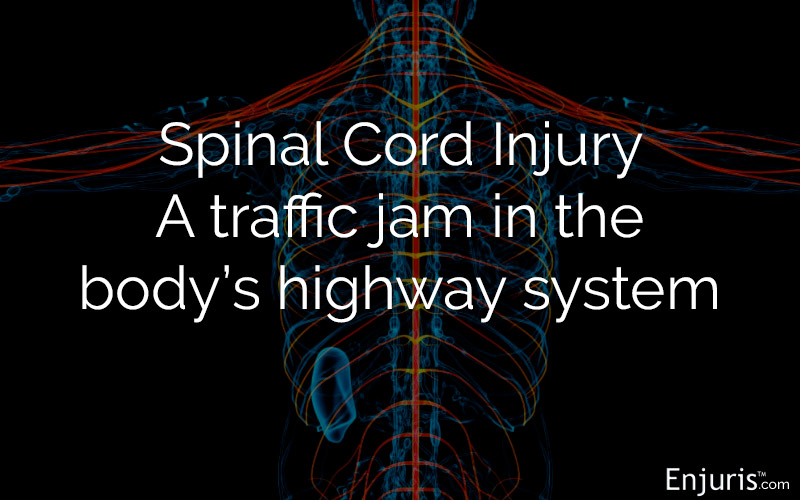An accident that damages your spinal cord can happen in an instant and change your life forever
Your spinal cord is the information superhighway of your body.
This complicated bundle of nerves runs from the base of your skull all the way down to your hips, carrying electrical impulses called neurons from your brain to every other part of your body. If a body part is hurt or damaged in an accident, that information is carried back to the brain via the spinal cord for processing. That is how you feel pain.
The spinal cord is extremely delicate and is surrounded by bones called vertebrae. These make up the spinal column, which work to protect the spinal cord. Neurons travel from the brain through the spinal cord to spinal nerve roots, where they branch off to other areas of the body. They command muscles in the body and tell them when and how they should move.
This means that if the spinal cord is damaged, that information superhighway is brought to a halt either temporarily or permanently, depending on how severe the injury is.
The data cannot reach the brain. A spine injury can be caused by anything – car accidents, swimming mishaps, fighting gone wrong, illness, wrestling – it just has to crack through the protective casing of the vertebrae and hit the inner spinal cord.
What does a spinal cord injury mean?
The higher up on your spine the injury is located, the worse the damage is. These can be "complete" or "incomplete" injuries, which is based on whether you can feel any movement or sensation beneath the level of injury.
An incomplete injury means that the superhighway is still partially intact – messages can still reach the brain. You might be able to wiggle a toe or feel part of your leg. A complete injury, on the other hand, means that you feel absolutely nothing beneath the level of injury. Surgery can sometimes relieve pressure on the spinal tissue, but results vary widely and everybody's recovery is different.
Tweet this
Depending on the injury, you might experience a loss of sensation in parts of your body; an inability to move, loss of control your bladder or loss of control your bowels; the inability to control your sexual functions; pain or stinging; and spasms or intense reflex actions.
Until World War II, a serious spinal cord injury usually meant death because doctors could not cope with the secondary health problems.
Recovery is now more hopeful for those with incomplete injuries, and research is always being conducted in terms of medications and mobility assistance devices. That, along with epidural stimulation, exercise rehabilitation and electric stimulation, is all being used to help patients achieve a more normal life.
What happens at each level of the spine?
Depending on where along the spine you are injured, the results can be very different.
- Higher cervical injuries (C1-C4 vertebrae):
- Most severe injuries/cause the most damage
- Patient usually requires around-the-clock care
- Can result in arm, hand, leg and trunk paralysis (quadriplegia)
- Patient might not be able to breathe without assistance
- Patient's ability to speak or cough can be compromised
- Patient might not be able to control his or her bowels
- Lower cervical injuries (C5-C8 vertebrae):
- These nerves control the arms and hands
- Patient might feel pins and needles, tingling or pain
- Might be some or total paralysis in trunk, hands, wrists and legs
- Patient will likely be able to breathe and speak without assistance, though it will take considerable effort
- Little to no control of bowels or bladder
- Thoracic injuries (T1-T5):
- These nerves affect muscles in the upper chest, mid-back and abdominal region
- Patient's arms and hands are usually normal
- Injuries affect the trunk and legs, resulting in paraplegia
- Thoracic injuries (T6-T12):
- These injuries result in normal upper-body function and lower-body dysfunction, generally paraplegia
- Little to no control of bowels or bladder
- Lumbar injuries (L1-L5):
- Patient will experience loss of function in hips and legs
- Little to no control of bowels or bladder
- Sacral injuries (S1-S5):
- Injuries will manifest as a loss of function in hips and legs
- Little to no control of bowels or bladder
- Patient will likely be able to walk
What else can happen if I've had a spinal cord injury?
An injury to your spinal cord is difficult to handle, but there are other secondary issues that you need to watch out for.
Anything from muscle atrophy (the deconditioning of muscles) to sexual dysfunction to respiratory distress could occur, as well as circulation issues. Special compression clothing might need to be worn in order to push blood through your veins. Additionally, the patient will likely suffer from situational depression, given what is happening in his or her life.
It helps to have a caregiver in health situations such as these, because even if you have "just" a sacral injury, for example, you will still experience significant difficulty adjusting to your new life.
Resources and information
Spinal cord injuries, for all the damage they can do, are not always immediately obvious.
If you think you've suffered damage to your spinal cord, do not move. Remain where you are and call 911 or have someone get medical assistance on your behalf. Have someone place heavy towels on either side of your neck to keep you from moving until the medical team arrives. Perform basic first aid in the meantime. If you are by yourself, call 911 and then move as little as possible until they arrive.
Spinal cord injuries are debilitating and difficult to handle. Look through our resources to see if there are groups that can help you focus on healing.
See our guide Choosing a personal injury attorney.

